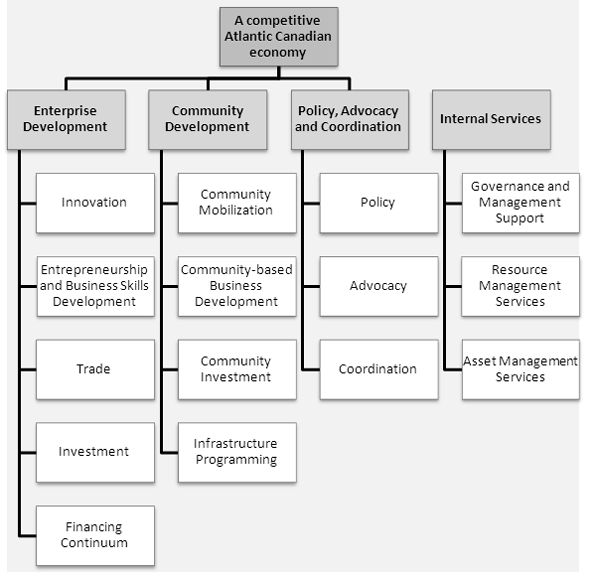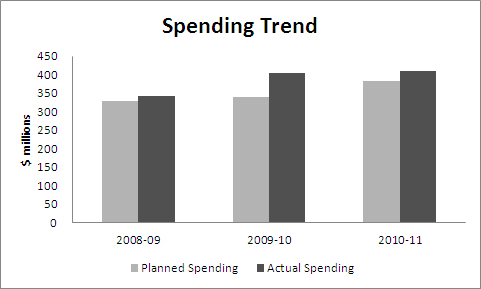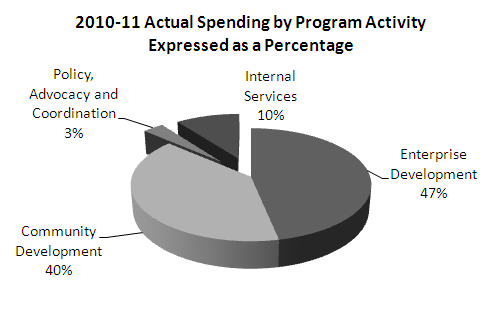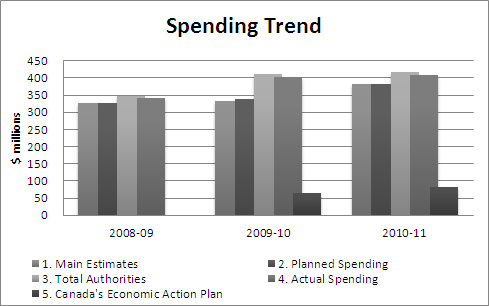Common menu bar links
Breadcrumb Trail
ARCHIVED - Atlantic Canada Opportunities Agency - Report
 This page has been archived.
This page has been archived.
Archived Content
Information identified as archived on the Web is for reference, research or recordkeeping purposes. It has not been altered or updated after the date of archiving. Web pages that are archived on the Web are not subject to the Government of Canada Web Standards. As per the Communications Policy of the Government of Canada, you can request alternate formats on the "Contact Us" page.
Minister’s Message

It is my pleasure to present the Atlantic Canada Opportunities Agency’s (ACOA) 2010-11 Departmental Performance Report.
In 2010-11, Canada started to see signs of recovery from the global economic crisis. Because our Government acted quickly to put in place stimulus initiatives designed to protect our national economy and support Canadians through the recession, Canada was able to navigate through the economic downturn to emerge in a position of strength and as a model for the industrialized world.
ACOA has long played a significant role in strengthening Atlantic Canada’s economy by providing support to communities and by helping small and medium-sized businesses become more innovative, productive and competitive. In 2010-11, the Agency was also instrumental in delivering our Government’s economic stimulus initiatives in the Atlantic region. Through the Community Adjustment Fund and the Recreational Infrastructure Canada program, communities across Atlantic Canada received support to renew infrastructure and be more innovative in resource industries, which helped to create and maintain much-needed jobs.
Our Government will continue to provide strong, stable stewardship of the national economy to ensure Canada’s full recovery from the economic downturn and lay a foundation for long-term security and prosperity for Canadians from coast to coast to coast. And in Atlantic Canada, ACOA will continue to play a key role in the delivery of federal programs and initiatives, to the ongoing benefit of the communities and small businesses of this region.
The Honourable Keith Ashfield
Minister of Fisheries and Oceans and
Minister for the Atlantic Gateway
Minister of State’s Message

One of the strengths of the Atlantic Canada Opportunities Agency (ACOA) is its ability to identify and address the economic challenges and opportunities of the Atlantic region. Working with its many partners, the Agency has a strong record of designing and delivering effective programming that helps businesses to start up and grow, and communities to prosper.
Our Government recognizes the value of the work ACOA does in Atlantic Canada. That is why, between 2009 and 2011, the Agency was given responsibility for designing and implementing Economic Action Plan initiatives in the region, which created jobs and supported Canadians during the global economic recession.
With Canada’s economic recovery under way, jobs and growth remain our Government’s top priority. In 2010-11, ACOA focused on promoting the development of critical workforce skills and on encouraging research and development as key engines of economic growth and job creation in Atlantic Canada. The Agency continued to provide effective support for innovation through the Atlantic Innovation Fund and the Business Development Program. It also pursued its work to open new markets for businesses across Atlantic Canada to support the region’s prosperous engagement in the global economy.
This report outlines the many key successes ACOA achieved over the fiscal year 2010-11 and clearly demonstrates how the Agency is an effective partner and tireless champion of this region.
The Honourable Bernard Valcourt
Minister of State
(Atlantic Canada Opportunities Agency)
(La Francophonie)
Section I: Organizational Overview
Raison d’�tre
The Atlantic Canada Opportunities Agency (ACOA) works to create opportunities for economic growth in Atlantic Canada by helping businesses to become more competitive, innovative and productive, by working with communities to develop and diversify local economies, and by championing the region’s strengths in partnership with Atlantic Canadians. It plays an important role in developing and supporting policies and programs that strengthen the region’s economy. This work addresses the Agency’s mandate “to increase opportunity for economic development in Atlantic Canada and, more particularly, to enhance the growth of earned incomes and employment opportunities in that region” (Atlantic Canada Opportunities Agency Act, R.S.C., 1985, c. 41, 4th Supp.).
Responsibilities
Established in 1987, ACOA is the federal department responsible for the Government of Canada’s economic development efforts in the provinces of New Brunswick, Prince Edward Island, Nova Scotia, and Newfoundland and Labrador.
ACOA’s head office is in Moncton, New Brunswick. Offices are located in all four provincial capitals in Atlantic Canada, each led by a regional vice-president. The Agency also provides services via a range of local field offices throughout the four provinces. In addition, through its Ottawa office, ACOA ensures that Atlantic Canada’s interests are reflected in the policies and programs developed by other departments and agencies of the federal government.
Although the Agency’s policies and program tools have evolved since its inception, the overall goal remains constant. ACOA helps the Atlantic region to realize its full economic potential in terms of productivity, competitiveness and growth. This is achieved by identifying and addressing structural changes in the economy, helping communities and businesses to overcome challenges, and finding new opportunities for growth. ACOA is committed to helping the region make the transition to a more innovative, productive and competitive economy.
Strategic Outcome and Program Activity Architecture
The diagram below illustrates ACOA’s strategic outcome (a competitive Atlantic Canadian economy) and Program Activity Architecture (PAA). The PAA is based on the results of policy research and analysis, the periodic assessment of program relevance and performance, ongoing dialogue with stakeholders in the region, and the priorities and directions of the Government of Canada.
ACOA’s PAA for 2010-11 comprised four program activities (shaded pale grey below) and 15 program sub-activities.

Organizational Priorities
Legend for the “Status” of each priority (below) and the “2010-11 Performance” of each program activity (section II).
Met all: 100% of the expected performance level (or target) was achieved.
Mostly met: 80% to 99% of the expected performance level (or target) was achieved.
Somewhat met: 60% to 79% of the expected performance level (or target) was achieved.
Not met: less than 60% of the expected performance level (or target) was achieved.
All organizational priorities support the Agency’s strategic outcome: A competitive Atlantic Canadian economy.
| Priority | Type1 | Program Activity |
|---|---|---|
| Productivity and competitiveness | Ongoing | Enterprise Development Policy Advocacy and Coordination |
| Status: Exceeded | ||
|
||
| Priority | Type | Program Activity |
|---|---|---|
| Innovation and commercialization | Ongoing | Enterprise Development |
| Status: Exceeded | ||
|
||
| Priority | Type | Program Activity |
|---|---|---|
| International business development and strategic foreign markets | Previously committed to | Enterprise Development |
| Status: Met all | ||
|
||
| Priority | Type | Program Activity |
|---|---|---|
| Deliver on Budget 2009 – Canada’s Economic Action Plan (CEAP) | Previously committed to | Community Development |
| Status: Exceeded | ||
|
||
| Priority | Type | Program Activity |
|---|---|---|
| Public service renewal and business/human resources integration |
Ongoing | Internal Services |
| Status: Met all | ||
|
||
| Priority | Type | Program Activity |
|---|---|---|
| Internal services | Ongoing | Internal Services |
| Status: Met all | ||
|
||
| Priority | Type | Program Activity |
|---|---|---|
| Values and ethics | New | Internal Services |
| Status: Met all | ||
|
||
Risk Analysis
ACOA’s Response to the Changing Economic Landscape
ACOA operates within an evolving economic landscape. The Agency’s broad-based approach to economic development addresses the underlying structural challenges in the economy. To proactively identify opportunities, the Agency needs to assess external economic factors that could potentially affect the delivery of its programs and services. The following section provides an economic overview of the Atlantic region. A complete economic outline for the region, “Atlantic Canada’s Economic Overview and Provincial Economic Profiles,” is available in the supplemental information provided on ACOA’s website.
In 2010-11, the Atlantic Canadian economy recovered further from the financial crisis that seized the world over the last several years. The four Atlantic provinces dealt with the global recession relatively well compared to most other Canadian provinces, as the region’s economy posted positive shifts in its gross domestic product (GDP). These results were due, in large part, to heightened domestic demand for goods and services as well as federal and provincial stimulus programs.
Overall, employment numbers rose in the region, which positively impacted income growth. Increased income stimulated the Atlantic Canadian economy in many areas, notably the retail sector, which recorded higher sales in comparison to the previous year. With a rebounding American economy, Atlantic Canadian manufacturers experienced an upward trend in their export shipments. Altogether, there was growth in exports, explained primarily by increased shipments of refined petroleum products.
As part of ACOA’s response to the challenges and opportunities faced by the region in 2010-11, the Agency identified key risks it might encounter and developed mitigation measures to respond to them.
External Factors
In its 2010-11 Report on Plans and Priorities, ACOA identified three main external factors with the potential to impact the Agency’s policies and programs. Productivity, a skilled labour force and resource industries were highlighted as areas where Agency efforts might require heightened focus.
Productivity
Atlantic Canada’s productivity must improve in order to maintain and increase the region’s standard of living. Raising productivity levels requires higher rates of business investment in machinery and equipment, greater levels of research and innovation, more effort placed on developing a skilled workforce, and more spending on infrastructure.
These issues fall within the scope of ACOA’s mandate. Raising the levels of research and development (R&D), increasing innovation capacity and commercialization activity are fundamental to improving Atlantic Canada’s competitiveness and closing the productivity gap with the rest of the country. Through the Agency’s Atlantic Innovation Fund, ACOA invested in large, cutting-edge R&D projects with the private sector, universities and research institutes. The Business Development Program, via its innovation element, provided targeted funding for R&D projects and for the adoption and/or adaptation of leading-edge technologies that enhance the productivity of Atlantic Canada’s economy.
Skilled Labour Force
As signs of economic recovery became increasingly evident in Atlantic Canada during the past year, many communities throughout the region continued to be tested. The Government of Canada, through ACOA, worked directly with communities across the region, as well as with SMEs and numerous partners in all four Atlantic provinces, to build a strong and competitive Atlantic Canadian economy where
the labour force demonstrated the appropriate skills required to support an evolving economy.
The Agency supported projects and initiatives that addressed gaps identified between evolving needs and the attributes of the current workforce. Through targeted efforts, such as those seen with Entrepreneurship and Business Skills Development, including its youth and women entrepreneurs programming, as well as the Agency’s continued involvement with the four Atlantic Provinces and other
federal departments in the Atlantic Population Table, ACOA addressed the issue of a skilled Atlantic Canadian labour force.
Resource Industries
Resource-based industries played an important role in the region’s economy in 2010-11. Through its various programs and initiatives, ACOA assisted in the development of more innovative and competitive resource industries, contributing to a more robust and sustainable economy for the rural areas of the region where the economic base is most often tied to traditional sectors such as forestry, agriculture and fishing.
One clear example of ACOA’s role in resource industries was seen through the Community Adjustment Fund (CAF) under Canada’s Economic Action Plan. The Agency earmarked federal funds to resource industries such as the lobster fishery, where instability witnessed a few years ago seems to persist. Through the CAF-Lobster Initiative, the Agency provided stimulus programming to support diversification efforts within the lobster industry in a timely and focused manner. This contributed to the viability of the lobster industry and the (mostly rural) communities that depend on the fishery. With ACOA’s experience in managing federal funding programs in the region, the delivery of CAF-Lobster funds and other funds related to CAF assisted resource industries and rural areas in offsetting the economic pitfalls brought on by the global economic crisis.
Internal Factors
The Agency’s key risks were determined through an internal review with senior management and an analysis of related documentation and information. They were approved by ACOA’s Executive Committee and were constantly monitored to ensure implementation of appropriate mitigation measures.
During the fiscal year, considerable progress was achieved on the implementation of mitigation measures. For example, the Agency focused on the risk associated with the potential of having insufficient financial and operational information to support decision making. In response to this risk, significant mitigation was achieved through the creation of dashboards, which contain key data required to support the Agency’s operational and financial health. Timely data is provided to senior management on a consistent schedule.
Similarly, the Agency completed several mitigating measures in response to the people management risk. These included an Integrated Business and Human Resources Plan and the Program Delivery Curriculum. These two initiatives, along with other measures, were directed specifically toward areas where ACOA’s management wanted to ensure that a robust response was undertaken.
These mitigating measures, along with those listed in the table below, have contributed to lowering the level of residual risk associated with the Agency’s key risks.
| Key Risk/Challenge | Mitigation Measure |
|---|---|
| Management Information Risk Risk that senior management does not have readily accessible, comprehensive, targeted data to understand the financial and program health of the organization and support decision making. |
In fiscal year 2010-11, executive dashboards were used and presented monthly to ACOA’s Executive Committee as a mechanism to provide management with a real-time window on performance indicators in a format designed to support timely and effective management decision making. The objective was to provide relevant data and analysis on the Agency’s current performance, to identify trends and to assess these against performance targets. These dashboards have assisted management to steer the organization, to identify and address issues and opportunities early for continued improvement. |
| People Management Risk The risk that ACOA’s talent agenda (leadership, recruitment, training, promotion, work-life balance, competencies) does not adequately sustain the necessary workforce required to carry out the Agency’s mandate in the future, and that the Agency experiences a significant loss of corporate memory and has difficulty implementing change management. |
The Agency established output targets, a People Management program, an Integrated Business and Human Resources Plan, values and ethics training, an enhanced continuous learning plan and a Program Delivery Curriculum, all of which ensured consistent and effective delivery of Agency services and programs. |
| Financial Accountability Risk The risk that ACOA will have difficulty fulfilling its responsibilities for compliance with Treasury Board's requirements relating to financial management policies. |
During 2010-11, ACOA worked diligently with business leads in documenting all key business processes to support the evaluation of controls within each process. External expertise was hired to validate the progress made to date in implementing Treasury Board's policy on internal controls. |
During fiscal year 2010-11, an internal audit of Corporate Risk Management was conducted. The audit concluded that the Agency is complying with Treasury Board of Canada Secretariat’s guidance in its direction and approach to risk management. The audit recommended improvements, which management has agreed to and is implementing. These recommendations centred around increasing awareness, integrating risk management into operations, and reducing the reliance on the Chief Risk Officer to maintain risk management processes and dialogue. In response, the Agency has established a Risk Management Committee with representatives from each region and various divisions. This committee will be an important resource to facilitate the assessment of risk as well as the integration of risk management into operations.
Summary of Performance
2010-11 Financial Resources ($ millions)
| Planned Spending | Total Authorities | Actual Spending |
|---|---|---|
| 382.1 | 417.3 | 408.4 |
2010-11 Human Resources (Full-time Equivalents)
| Planned | Actual | Difference |
|---|---|---|
| 711 | 714 | (3) |
| Performance Indicator | Target2 | 2010-11 Performance |
|---|---|---|
| Increase in Atlantic gross domestic product (GDP) for every dollar of ACOA expenditure in direct support of business | $4.50 | On track. Performance is calculated for a five-year period, which will end in 2012-13. Result reported for the period 2003-04 through 2007-08 was $7.20.) |
| Program Activity | 2009-10 Actual Spending ($ millions) |
2010-11 3 ($ millions) | Alignment to Government of Canada Outcome | |||
|---|---|---|---|---|---|---|
| Main Estimates |
Planned Spending |
Total Authorities |
Actual Spending |
|||
| Enterprise Development | 192.2 | 174.3 | 174.3 | 196.8 | 191.0 | Strong Economic Growth |
| Community Development | 155.7 | 160.4 | 160.4 | 169.5 | 161.9 | |
| Policy, Advocacy and Coordination | 13.0 | 11.5 | 11.5 | 12.2 | 13.7 | |
| Total | 360.9 | 346.2 | 346.2 | 378.5 | 366.6 | |
| Program Activity | 2009-10 Actual Spending ($ millions) |
2010-11 ($ millions) | |||
|---|---|---|---|---|---|
| Main Estimates |
Planned Spending |
Total Authorities |
Actual Spending |
||
| Internal Services | 42.9 | 35.9 | 35.9 | 38.8 | 41.8 |
Expenditure Profile
The following graph shows planned versus actual spending for fiscal years 2008-09 through 2010-11.

ACOA’s actual spending for 2010-11 was $408.4 million. Compared with actual spending of $403.8 million in 2009-10, this represents an increase of 1%, or $4.6 million. Variances in actual spending profiles are due to a decrease of $1.6 million in operating expenditures, offset by an increase of $6.2 million in grants and contributions. The increase in grants and contributions is explained as follows:
- an increase of $10.9 million under Canada’s Economic Action Plan for the Community Adjustment Fund;
- an increase of $8.2 million under Canada’s Economic Action Plan for the Recreational Infrastructure Canada program;
- an increase of $3.0 million under the Saint John Shipyard Adjustment Initiative;
- a decrease of $13.8 million under the Innovative Communities Fund;
- a decrease of $1.9 million under the Atlantic Innovation Fund; and
- other changes resulting from normal program fluctuation, representing a decrease of $0.2 million.
Analysis of 2010-11
Planned spending of $382.1 million was augmented by $35.2 million provided through new authorities and transfers, including $19.0 million in ongoing funding for the Atlantic Innovation Fund and the Innovative Communities Fund, $5.1 million for the Community Adjustment Fund, $2.4 million under the Business Development Program, $1.7 million in ongoing funding for the Community Futures program, $4.0 million for operating budget carry forward, $1.2 million for severance pay, parental leave benefits and leave payout, and $1.8 million in various other minor adjustments.
Actual spending of $408.4 million resulted in a surplus of $8.9 million from total authorities of $417.3 million. The Agency will access a portion of this surplus through an operating budget carry forward of $4.2 million and will request a reprofiling of $3.4 million under the Recreational Infrastructure Canada program to meet planned requirements in 2011-12.
Analysis by Program Activity
Actual spending of $191.0 million for the Enterprise Development program activity resulted in a surplus of $5.8 million from total authorities of $196.8 million. This variance occurred because the Saint John Shipyard Adjustment Initiative was originally to be expended under the Enterprise Development program activity at $10 million. This shortfall in expenditures was offset by an increase in programming under the Business Development Program compared with the original planned authorities for the program.

Actual spending of $161.9 million for the Community Development program activity resulted in a surplus of $7.6 million from total authorities of $169.5 million. This variance was due to decreased programming under the Innovative Communities Fund totalling $11 million, as a result of the timing of the program’s renewal and the emphasis placed on the delivery of initiatives under Canada’s Economic Action Plan. This shortfall was offset by $3 million in expenses against the Saint John Shipyard Adjustment Initiative, originally planned to be expended in the amount of $10 million under the Enterprise Development program activity.
Actual spending of $13.7 million for the Policy, Advocacy and Coordination program activity exceeded planned authorities of $12.2 million by $1.5 million, mainly due to the additional resources required to respond to the Strategic Review identified in Budget 2010 and other unplanned expenses.
Although actual spending of $41.8 million for the Internal Services program activity exceeded total authorities of $38.8 million, it represents a decrease of $1.1 million compared with the previous year’s expenditures for this program activity.
Canada's Economic Action Plan (CEAP)
Under the CEAP, ACOA was responsible for the delivery of RInC, CAF, and the ongoing Canada Business Network funding in Atlantic Canada. The Agency spent a total of $81.3 million in 2010-11 as detailed in the following table and spending graph.
Departmental Spending Trend
| CEAP Initiative | 2010-11 ($ millions) | ||
|---|---|---|---|
| Planned Spending | Total Authorities | Actual Spending | |
| Community Adjustment Fund | 50.1 | 55.1 | 57.9 4 |
| Recreational Infrastructure Canada | 24.3 | 24.3 | 20.8 |
| Canada Business Network | 2.6 | 2.6 | 2.6 |
| Total | 77.0 | 82.0 | 81.3 |

Estimates by Vote
For information on ACOA’s organizational votes and/or statutory expenditures, please see the Public Accounts of Canada for 2011 (Volume II) publication. An electronic version of the Public Accounts is available on the Public Works and Government Services Canada website.5
